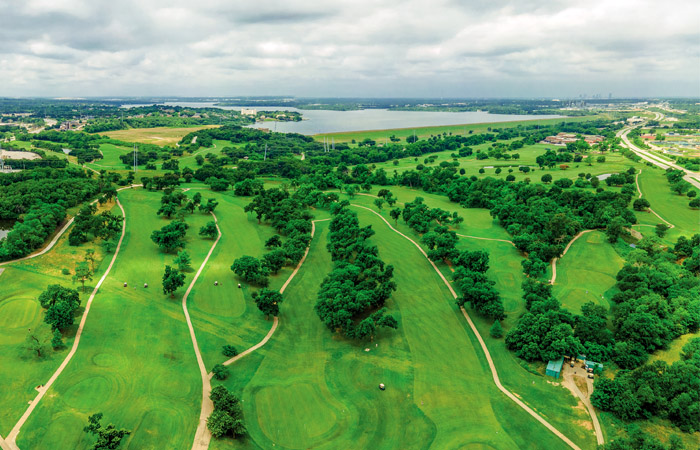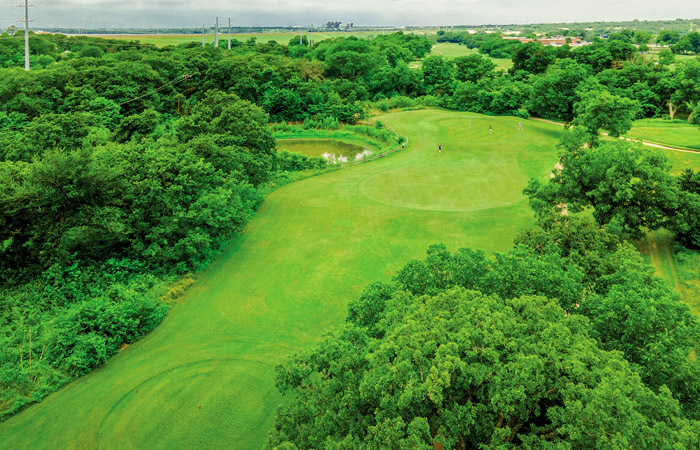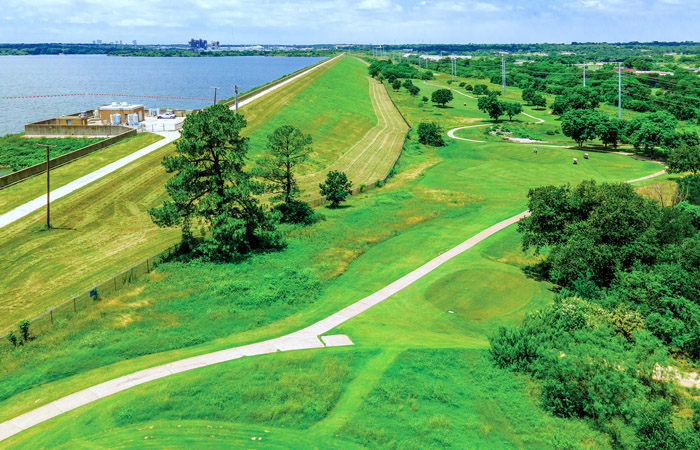I have been on record for years as saying Lake Arlington Golf Course just might be the best bang for the buck in DFW. Course conditions have been great for the better part of a decade, the greens are some of the only ones in the area that have seen zero Poa Annua in the last few years, and some other recent updates have the course as good as it has ever been.
The opening hole at Lake Arlington seems fairly straightforward. However, one thing that should be noted is The Lake doesn’t have a driving range, so it can be a little tough to loosen up before your round. There is a putting green and another satellite green just a few yards from the 10th tee where you can hit some chip shots. But if you want a true warm-up, you will have to find a range elsewhere before you head to the course. That being said, this can make No. 1 a bit challenging, as it is not only one of the longest par 4s on the course, but tackling it with no warm-up can be tough. Favor the right center of the fairway for the best angle, but if you are a true long hitter, fire one right down the cart path on the left and try to carry the slight dogleg. This leaves only a short iron remaining.

For the most part, Lake Arlington is a right-in-front-of-you course, especially on the front nine. It can be gettable if you are hitting the ball well. One of the main defenses at The Lake is its collection of par 3s. No. 2 can play close to 200 yards from the tips, although it rarely tipped all the way back. Usually, even from the back tees, it only plays about 180 or so. But with water left and a significant runoff right, hitting the middle of the green is paramount. If you do miss, be sure to come up a little short, as this offers the best place to pitch from. If you can open your round with back-to-back pars or better, you are setting yourself up for a potentially solid opening nine.
No. 3 and No. 4 parallel one another. Water to the right of the fairway on No. 3 is blind, so make a note that it’s there and choose your club on the tee properly. Longer hitters can easily reach the water on the right with a driver or even a three-metal. Laying back with a long iron or hybrid still only leaves a short iron remaining, so avoid the water at all costs. A multi-tiered green protects wedge shots, so you must be precise.

No 4., although it usually plays back into a predominant south wind, isn’t the longest par 4 in the Metroplex. In fact, longer hitters can challenge the front edge of the green when there is no wind and in firmer late summer or winter dormant conditions. Most players will have a simple wedge into this green, making this one of the best opportunities for birdie on the opening nine.
The par-4 fifth hole is one that has undergone some changes over the last decade. Trees planted just in front and to the left of the tee now force players to hit a high draw or take less than a driver to keep tee shots out of a small pond that isn’t visible from the tee. Find the fairway, and the chances of a par or better increase exponentially.

After another par 4 at No. 6 comes the improved par-3 seventh hole. Although the hole is the same, some recent tree pruning and removal have opened up the views of the meandering creek that separates the back tees and the forward boxes. In addition, leveling of the back tee is a welcome improvement, making hitting a long iron much easier than the old box that promoted a hanging lie.

No. 8 is one of the most interesting holes on this par-71, Ralph Plummer design. This hard dogleg left can be navigated in a couple of ways. For the bombers, a line directly over the dogleg and the trees will leave nothing more than a wedge. For those who want to take a more conservative approach, play straightaway to the corner of the dogleg, which leaves a mid-iron into the green.
No. 9 is a great little par 5 that can springboard your momentum for the final nine. Fire a good tee shot up the right center, and this will leave a mid-iron or less for the longer hitters. For those who don’t want to challenge the green in two, lay up and leave a comfortable wedge number. This green can be a little challenging depending on pin placement, as it slopes severely from right-to-left.
After a relatively flat front nine, the back nine at The Lake offers some more interesting topography and architectural elements. In my experience, the back will play at least a couple of shots harder. Another par 4 at 10 features a carnival green that can be extremely quick when above the hole.
To this point in the round, Lake Arlington has been relatively forgiving. Sure, there are some native grasses and a couple water hazards to navigate on the front, but the real challenge at The Lake begins with the tee shot on No. 11. This hole has tightened up over the years, where anything right of the cart path will careen down into shin-high grasses or a pond that sits between 11 and 12 fairways. Miss left and your ball, which would kick right off a rock-covered outcropping years ago, is now covered with gnarly grass and other native trees and plants and won’t spit back into the fairway as it once did. A long iron or hybrid is the play here, as this is the toughest fairway to hit on property. Should you find the fairway, I find this approach always plays at least a half club more than the yardage reads, as there is often a little south wind that wants to take some yardage off. This hole can be a real Rubik’s cube for some, but walk away with a par and you’re likely picking up a shot on your group.
No. 12 is another interesting hole, with a sweeping fairway that trundles down to the right, making this a dynamic tee ball. Taking an aggressive line over the corner of the water will send shots tumbling to the bottom of the hill but can leave an awkward wedge to an elevated green. Playing out to the left off the tee will take the water out of play but leave a longer shot, which will be harder to hold. Pin placement is paramount. When in front, it can be better to advance the ball as far as possible; when in back, a longer shot that will release into the green and chase to the back might be more appropriate. The green here can be tough to read as it runs severely from back-to-front.
Arguably, the most difficult hole is No. 13. Over the years, as club and golf ball technology have advanced, this hole isn’t quite as daunting as it once was, as longer players can now just rip a driver over the dogleg, leaving just a short iron or even wedge. For mid-cappers, this hole can still be a tough customer, as getting a tee shot to the top of the hill can be tough. This will leave a long approach to an elevated green that is deep front-to-back, but narrow side-to-side. In fact, this green is so deep and the approach plays uphill, so adding a full club for back pin placements might be necessary.

No. 14 is still to this day one of my favorite par 3s in the area. With a scenic view of Lake Arlington off to the left, this hole plays a muscular 245 from the tips. And though it appears to play extremely downhill, I have found over the years that the elevation change doesn’t seem to impact the actual number. It essentially plays the number you get, so you need to trust the yardage.
Back-to-back par 5s come next at No. 15 and No. 16. Longer hitters can reach 15 in optimal conditions, but 16 will play as a three-shot hole for all but the elite players. Each can be a good chance to add a birdie to the card as your round nears completion.
Of all the par 3s at Lake Arlington, No. 17 might be the most perplexing. There isn’t much to it, as it plays just about 210 from the back tees. But for some reason, it always seems to play at least one club longer than the card reads. There is usually a little south wind that will hit iron shots as they climb above the tree line, but even on calm days, it seems to play a little longer than the yardage would suggest.
The final hole at The Lake is a relatively short par 4, playing just about 380 from the tips. A good shot up the left center will leave just a short iron or wedge, and one final opportunity at a birdie.
The clubhouse at Lake Arlington is fairly rudimentary, but they do carry plenty of balls, gloves and some other gear, should you need to stock up before your round. The old-school snack bar offers some solid food when available, including some breakfast burritos and other items on the weekends. Beer is available, but no liquor. So if you are one who enjoys the Transfusion or a shot of Fireball while you play, you won’t see those at The Lake. When the weather is friendly, the patio is a nice place to sit, enjoy a beer and watch some groups come in on Nos. 9 and 18.
Over the last decade or so, as other courses have seen struggles with greens or other aspects of their courses, Lake Arlington has been as consistently good as any course in the Metroplex, especially given its budget-friendly rate. One thing I enjoy with newcomers to Lake Arlington is counting the number of holes played before they notice there are no bunkers. For some, the entire 18 elapses without them noticing, while others mention it within the first few holes.
The lack of bunkers may be a strike against the course for some, as architecture purists enjoy the way bunkers frame holes and how they add to the overall aesthetic. But in my mind, the lack of bunkers can be a strength in a couple of ways. For starters, bunkers are expensive to maintain, and with municipal courses often scratching and clawing for every dollar the city can spare, not having bunkers allows the course superintendent to utilize those dollars on other aspects of the course … greens, for example. Would you rather have average greens and bunkers, or no bunkers and perennially great putting surfaces? I know I would rather have great greens than bunkers that are constantly being washed out by intense rains and slow the course, as the average player takes two shots every time, they’re in one, and then have to spend time raking it (if they even bother). Less maintenance and increased pace of play? Yeah. That’s enough for me not to worry about the lack of bunkers.
Lake Arlington is a great course for the novice and the expert player alike. Short-game options around most of the greens make this more user-friendly, and the par 3s alone add a lot of challenge. Add this with some really gettable holes on the front nine, and you have a fun day of golf for any skill level.